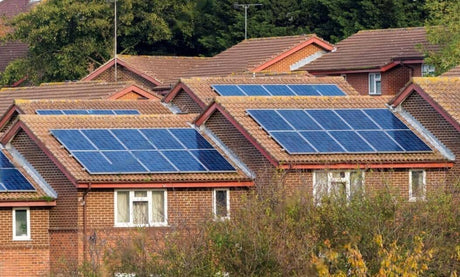You may have never heard of a DC to DC battery charger. For most automobile owners, the only battery they need to worry about is the starter battery used to power their car’s electrical system. Then, as you drive, an alternator charges your car’s battery, keeping it charged sufficiently to prolong the battery life.
However, for those attempting to move off the grid by occupying a caravan or a converted van, or for anyone taking one of these vehicles camping, a DC to DC battery charger is an important piece of equipment. These battery chargers allow you to channel power from your alternator to your secondary batteries, fully charging them as well.
This article will look at how DC to DC battery chargers work and how you can easily integrate one of these chargers into your solar installation. We’ll also look at the numerous benefits you’ll enjoy with a DC to DC battery charger. You’ll find that these chargers aren’t just a convenience—they’re a valuable part of your battery management system.

The Basics of the DC to DC Battery Charger
Batteries function on direct current (DC), in contrast to the alternating current (AC) you get from your electrical outlets. When it comes to charging a battery, it can only accept DC power. Chargers that rely on AC power must have a way to transform that current into DC, usually with a converter either at the charger or on the battery itself.
DC to DC chargers, on the other hand, don’t need conversion. Instead, they can directly charge a battery. Not only does this save money and space otherwise spent on extra equipment, but it also minimizes the power loss experienced in the conversion process.
You may already be familiar with some forms of DC to DC battery chargers. Electric vehicle (EV) chargers, for instance, can run on either AC or DC power. For DC models, the electricity is transformed before it leaves the station, meaning your car doesn’t require a converter along the charging pathway.
You may also have used a portable car battery charger. While you typically charge these units by plugging them into a wall socket, they supply direct current to your car’s battery, which will ideally provide a dead battery enough charge to start. Once the car starts, then the alternator takes over, charging the battery back to 100%.
On-Board DC to DC Battery Chargers
For those with dual battery systems in their vehicles, the most important DC to DC battery chargers are the ones you install onboard your vehicle. While your alternator can quickly charge your starter battery, the secondary, deep cycle batteries require a different charging cycle to charge effectively.
Several years ago, battery isolators were the best devices for charging secondary batteries. These components would channel excess power from the alternator away from the starter battery once it was fully charged, sending that electricity back to what’s usually known as the “house” battery.
However, there were several lapses and deficiencies to this method. First, the power transfer was relatively inefficient. Second, isolators don’t work well with lithium batteries, which are becoming the standard. And finally, modern cars began to come equipped with what are called smart alternators.
Unlike older models, smart alternators stop producing excess current once the starter battery is fully charged, protecting the battery while limiting the wear and tear of excess energy production. This method makes isolators ineffective, meaning DC to DC battery chargers are increasingly necessary parts of your secondary battery management system.
DC to DC battery chargers are usually installed close to the house battery, where they amplify and smooth the power supply to the secondary battery. In a sense, the DC to DC battery chargers “trick” the alternator into continuing to run after the starter battery is charged, diverting that power instead. As a result, your alternator charges your second battery as you drive your car.
Connecting your DC to DC charger to your vehicle is relatively straightforward. You simply attach the positive and negative leads from each battery to either side of the charger, then connect a wire from the charger to the ignition system. When the ignition turns on, it signals your charger that the alternator has engaged, which turns on the charger itself.
Bear in mind that you should install either circuit breakers or fuses on both sides of the charger. That way, if your electrical system experiences a surge, you’ll protect your sensitive equipment. While both options will work, a circuit breaker will spare you the inconvenience of having to replace a fuse while giving you the ability to control the power flow from a panel.
DC Chargers and Solar Panels
While DC to DC chargers are helpful on their own, they’re especially valuable for those looking to integrate their solar installation into their vehicle’s power system.
The best solution is installing a combination charge controller/DC to DC battery charger if you want to integrate. Since you’ll need a charge controller no matter what, spending an extra few dollars to include the charger will save you money in the long run.
These dual input chargers help you make the best use of all the power your setup can generate. While your car is driving, your solar panels can work with the alternator so that both sources charge your batteries. Or, if you’re on the road a lot, you might find you don’t need your solar panels to generate electricity at all, and you can switch them off until your car is no longer running.
Connecting Your Solar Equipment to a DC to DC Battery Charger
While it’s true that installing a dual input charger is a little more complicated than a standard DC to DC battery charger, it’s still a relatively straightforward process. Instead of positive and negative input for both batteries, these units have positive terminals for both the alternator and solar panel inputs and output to the house battery. A single negative terminal connects to all three sources.
Because these are more complicated pieces of equipment, dual input chargers also have several other input ports, including the following:
- Data port for communications
- A voltage sensor
- A temperature sensor
- A connection to the ignition system
Each port is clearly labeled, and with these additional sensors, you can be sure that your charger will be protected from any unexpected peaks or dips in the power supply. So whether you’re connecting to lead-acid or lithium batteries, your charger will make sure you have the power you need.
The Benefits of a DC to DC Battery Charger
Ease of Installation
Both DC to DC battery chargers and dual input chargers are quick and easy to install. While there may be some variations depending on your vehicle, the process is rather straightforward for the most part. If you’re building a solar panel system for your car, make a charger part of your solar panel installation process.
Prolonged Battery Life
Most batteries tend to work best when they’re charged to 100%. In fact, except for lithium batteries, you can damage your power storage systems by running them down—many manufacturers recommend keeping at least a 50% charge in your batteries.
With a DC to DC battery charger, you’ll keep your batteries charged simply by driving. And if you install a solar array as well, you’ll be even more likely to extend the life of your batteries.
Power When Solar Isn’t Producing
There are some times when your solar installation simply cannot produce power. Cloudy conditions and the nighttime sky can both make it impossible to generate electricity. With a DC to DC battery charger, you’ll ensure that you have the power you need to run your home, no matter what the conditions.
Relatively Inexpensive
When you’re planning your solar installation, adding a DC to DC charger usually amounts to a tiny portion of the overall cost of the system. When you compare that cost to the value you receive, installing an onboard charger is an easy decision.
Ultimate Power Flexibility
No matter where your vehicle takes you, with an integrated DC to DC battery charger, you can be sure that you’ll have access to power to turn your lights on and keep your appliances running. Sometimes you’ll have access to shore power, but you won’t be dependent on finding access to external power between the power generated by your solar array and your DC charger.
DC to DC Battery Chargers: A Smart Decision
For most people who choose to drive a caravan or converted vehicle, the decision is based on the idea of freedom—freedom from the electric grid, freedom from everyday life. Essentially, the freedom to take your life with you wherever you want to go.
If you want to make that possible, it’s wisest for you to use whatever resources are available. A DC to DC battery charger is a cheap, easy, and safe way to enhance your ability to ditch the power grid and strike out for an adventure.










